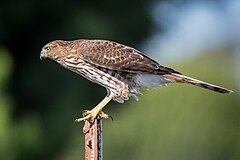Astur
Astur – rodzaj ptaków z podrodziny jastrzębi (Accipitrinae) w obrębie rodziny jastrzębiowatych (Accipitridae).
| Astur | |||
| Lacépède, 1799[1] | |||
 Krogulec czarnołbisty (A. cooperii) | |||
| Systematyka | |||
| Domena | |||
|---|---|---|---|
| Królestwo | |||
| Typ | |||
| Podtyp | |||
| Gromada | |||
| Podgromada | |||
| Infragromada | |||
| Rząd | |||
| Rodzina | |||
| Podrodzina | |||
| Plemię | |||
| Rodzaj |
Astur | ||
| Typ nomenklatoryczny | |||
|
Falco palumbarius Linnaeus, 1758 (= Falco gentilis Linnaeus, 1758) | |||
| Synonimy | |||
|
| |||
| Gatunki | |||
| |||
Rozmieszczenie geograficzne
edytujRodzaj obejmuje gatunki występujące w Ameryce, Eurazji i Afryce[9].
Morfologia
edytujDługość ciała 31,5–63 cm, rozpiętość skrzydeł 58–122 cm; masa ciała samic 342–2200 g, samców 190–1010 g[9].
Systematyka
edytujRodzaj zdefiniował w 1799 roku francuski przyrodnik Bernard Germain de Lacépède w publikacji własnego autorstwa poświęconej klasyfikacji systematycznej ptaków[1]. Gatunkiem typowym jest (późniejsze oznaczenie) jastrząb zwyczajny (A. gentilis)[10].
Etymologia
edytuj- Astur: łac. astur, asturis ‘jastrząb’, od gr. αστεριας asterias ‘jakiś rodzaj jastrzębia’, od αστηρ astēr, αστερος asteros ‘gwiazda’ (por. średniowiecznołac. austurcus, asturcius lub asturcus ‘jastrząb zwyczajny’)[11].
- Daedalion: w mitologii greckiej Daedalion, syn Lucyfera, tak bolał nad śmiercią swego syna Filonisa, że rzucił się z wysokości góry Parnas i został przemieniony w sokoła przez Apolla (por. gr. δαιδαλεος daidaleos ‘nakrapiany, oznaczony’)[12]. Gatunek typowy (późniejsze oznaczenie): Falco palumbarius Linnaeus, 1758 (= Falco gentilis Linnaeus, 1758)[13].
- Sparvius: fr. Épervier ‘krogulec’, od średniowiecznołac. sparverius ‘krogulec’[14]. Gatunek typowy (późniejsze oznaczenie): Falco palumbarius Linnaeus, 1758 (= Falco gentilis Linnaeus, 1758)[13].
- Asterias: gr. αστεριας asterias ‘jakiś rodzaj jastrzębia’, od αστηρ astēr, αστερος asteros ‘gwiazda’ (cf. αστεριας asterias ‘czapla, bąk’)[15].
- Phabotypus: gr. φαβοτυπος phabotupos ‘rażący, zabijający gołębie’, rodzaj jastrzębia wspomniany przez Arystotelesa, od φαψ phaps, φαβος phabos ‘gołąb, synogarlica’; τυπτω tuptō ‘uderzyć, razić’[16].
- Cooperastur: zbitka wyrazowa epitetu gatunkowego Astur cooperii Bonaparte, 1828[17]. Gatunek typowy (późniejsze oznaczenie): Astur cooperii Bonaparte, 1828[18].
- Leptohierax: gr. λεπτος leptos ‘delikatny, smukły’; ἱεραξ hierax, ἱερακος hierakos ‘jastrząb’[19].
- Neonisus: gr. νεος neos ‘nowy’; rodzaj Nisus Lacépède, 1799[20]. Gatunek typowy (oznaczenie monotypowe): Accipiter melanoleucus A. Smith, 1830.
Podział systematyczny
edytujDo rodzaju należą następujące gatunki[21]:
- Astur bicolor (Vieillot, 1817) – krogulec dwubarwny
- Astur cooperii (Bonaparte, 1828) – krogulec czarnołbisty
- Astur gundlachi Lawrence, 1861 – krogulec kubański
- Astur melanoleucus A. Smith, 1830 – jastrząb czarno-biały
- Astur henstii Schlegel, 1873 – jastrząb brunatny
- Astur gentilis (Linnaeus, 1758) – jastrząb zwyczajny
- Astur atricapillus (A. Wilson, 1812) – jastrząb czerwonooki
- Astur meyerianus Sharpe, 1878 – jastrząb papuaski
Uwagi
edytujPrzypisy
edytuj- ↑ a b B.G. de Lacépède: Tableau des sous-classes, divisions, sous-divisions, ordres et genres des oiseaux. W: B.G. de Lacépède: Discours d’ouverture et de clôture du cours d’histoire naturelle, donné dans le Muséum national d’Histoire naturelle, l’an VII de la République, et tableaux méthodiques des mammifères et des oiseaux. Paris: Plassan, 1799, s. 4. (fr.).
- ↑ M.J.C. Savigny: Description de l’Égypte, ou, Recueil des observations et des recherches qui ont été faites en Égypte pendant l’expédition de l’armée française. T. 1: Histoire naturelle. Paris: Imprimerie impériale, 1809, s. 68, 71. (fr.).
- ↑ L.J.P. Vieillot: Analyse d’une nouvelle ornithologie élémentaire. Paris: Deteville, libraire, rue Hautefeuille, 1816, s. 24. (fr.).
- ↑ F.O. Morris. A new system of nomenclature, illustrated by a list of British birds. „The Naturalist”. 2 (9), s. 123, 1837. (ang.).
- ↑ C.W.L. Gloger: Gemeinnütziges Hand- und Hilfsbuch der Naturgeschichte. Für gebildete Leser aller Stände, besonders für die reifere Jugend und ihre Lehrer. Breslau: A. Schulz, 1842, s. 211. (niem.).
- ↑ Ch.-L. Bonaparte. Tableau des oiseaux de proie. „Revue et Magasin de Zoologie pure et Appliquée”. 2e série. 6, s. 538, 1854. (fr.).
- ↑ C.J. Sundevall. Förnyad anordning av Dagrovfoglarna (Dispositio nova Accipitrum Hemeroharpagorum). „Öfversigt Konglica Svenska Vetenskaps-Akademiens nya Handlingar”. 31 (2), s. 24, 1874. (szw.).
- ↑ A. Roberts. Review of the nomenclature of South African birds. „Annals of the Transvaal Museum”. 8 (4), s. 208, 1922. (ang.).
- ↑ a b D.W. Winkler, S.M. Billerman & I.J. Lovette, Hawks, Eagles, and Kites (Accipitridae), version 1.0, [w:] S.M. Billerman, B.K. Keeney, P.G. Rodewald & T.S. Schulenberg (red.), Birds of the World, Cornell Lab of Ornithology, Ithaca, NY 2020, DOI: 10.2173/bow.accipi1.01 [dostęp 2020-06-02] (ang.), Accipiter.
- ↑ N.A. Vigors. Sketches in Ornithology ; or Observations on the leading Affinities of some of the more extensive groups of Birds. „The Zoological journal”. 1 (3), s. 326, 1824. (ang.).
- ↑ The Key to Scientific Names ↓, Astur [dostęp 2023-10-13].
- ↑ The Key to Scientific Names ↓, Daedalion [dostęp 2023-10-13].
- ↑ a b G.R. Gray: A list of the genera of birds: with their synonyma an indication of the typical species of each genus. London: R. and J.E. Taylor, 1840, s. 4. (ang.).
- ↑ The Key to Scientific Names ↓, Sparvius [dostęp 2023-10-13].
- ↑ The Key to Scientific Names ↓, Asterias [dostęp 2023-10-13].
- ↑ The Key to Scientific Names ↓, Phabotypus [dostęp 2023-10-13].
- ↑ The Key to Scientific Names ↓, Cooperastur [dostęp 2023-10-13].
- ↑ G.R. Gray: Catalogue of the genera and subgenera of birds contained in the British Museum. London: The Trustees, 1855, s. 134. (ang.).
- ↑ The Key to Scientific Names ↓, Leptohierax [dostęp 2023-10-13].
- ↑ The Key to Scientific Names ↓, Neonisus [dostęp 2023-10-13].
- ↑ Systematyka i nazwy polskie za: P. Mielczarek & M. Kuziemko: Plemię: Accipitrini Vigors, 1824 (wersja: 2024-07-07). [w:] Kompletna lista ptaków świata [on-line]. Instytut Nauk o Środowisku Uniwersytetu Jagiellońskiego. [dostęp 2023-07-23].
Bibliografia
edytuj- The Key to Scientific Names, J.A. Jobling (red.), [w:] Birds of the World, S.M. Billerman et al. (red.), Cornell Lab of Ornithology, Ithaca (ang.).